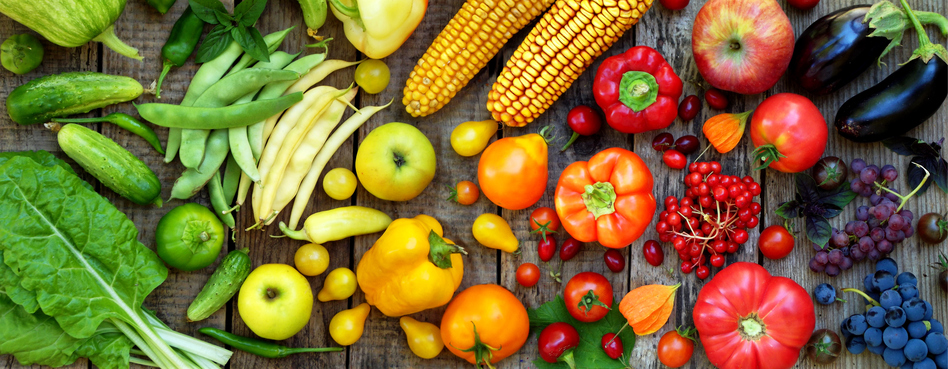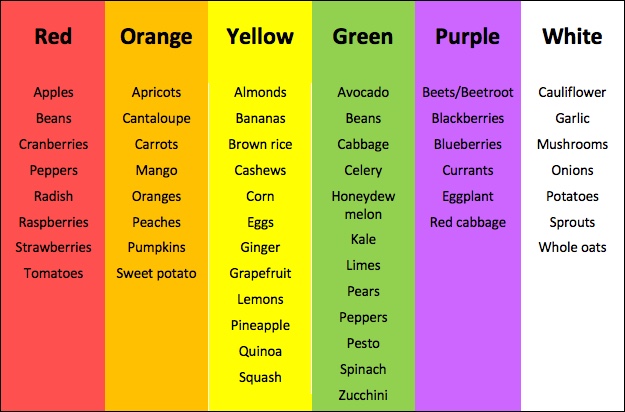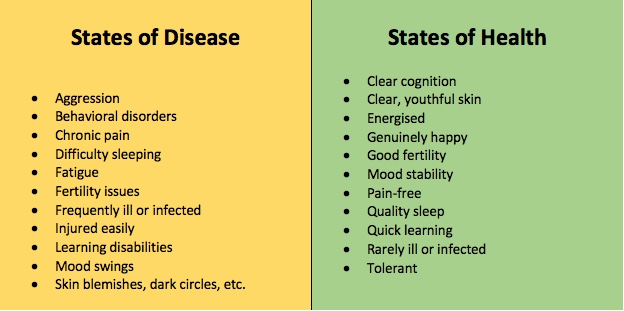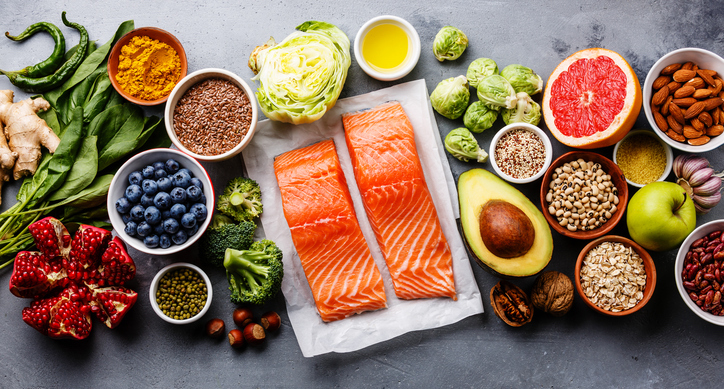Eating high-quality food is fundamental to providing good nutrition for the body. It is essential to ensure that food contains the maximum possible quantity of phytonutrients, vitamins, and minerals. This supports the body to utilize Food as Medicine.
The body also needs antioxidants, fatty acids, and fibre which can regularly be consumed from the diet. Without these crucial components in the diet, individuals can experience a reduction in overall quality of life, disease, and even death.
This article introduces principles worth considering to optimize food as medicine:
 Keeping these amazing medicinal foods along with all their benefits straight can be a challenge. Thus, many nutritional specialists recommend that you “eat the rainbow” meaning you should strive to consume as many colors of the rainbow as possible.
Eating in that manner ensures that most medicinal benefits are obtained from the diet. Get started by following this guide:
Keeping these amazing medicinal foods along with all their benefits straight can be a challenge. Thus, many nutritional specialists recommend that you “eat the rainbow” meaning you should strive to consume as many colors of the rainbow as possible.
Eating in that manner ensures that most medicinal benefits are obtained from the diet. Get started by following this guide:
 Another way to use food as medicine is to eat according to the organ or condition that is in need of improvement. For instance, garlic and onions are ideal for fighting bacterial or fungal infections. Animal- and plant-based forms of omega-3 fatty acids reduce inflammation in the body thereby alleviating arthritis, leaky gut, and some food allergies. Eating whole superfoods can greatly assist in avoiding overeating as well as junk food cravings ultimately lowering the risk of insulin resistance, blood sugar imbalance, obesity, and cancer.
Another way to use food as medicine is to eat according to the organ or condition that is in need of improvement. For instance, garlic and onions are ideal for fighting bacterial or fungal infections. Animal- and plant-based forms of omega-3 fatty acids reduce inflammation in the body thereby alleviating arthritis, leaky gut, and some food allergies. Eating whole superfoods can greatly assist in avoiding overeating as well as junk food cravings ultimately lowering the risk of insulin resistance, blood sugar imbalance, obesity, and cancer.

- What it means to use food as medicine
- The best medicinal foods for the diet
- How to determine when food is not the cure
- It’s not always what you eat, but how you eat it
What It Means to Use Food as Medicine
The ingredients necessary for a recipe for health include:- Balanced hormones
- Stable blood sugar
- Controlled inflammation
- Effective detoxification
- An alkalized body
Balanced Hormones
Balanced hormones boost the body’s energy level and cognition while maintaining body weight, libido, and many other processes. Disturbances in hormonal levels can lead to fatigue, depression, diabetes, obesity, autoimmune conditions, fertility issues, and even accelerated aging.Stable Blood Sugar
Stable blood sugar fights off insulin resistance, an underlying yet direct contributor to diabetes, weight gain, and obesity. Erratic blood sugar levels can affect hormone levels, produce neurological damage, and cause mood disorders.Controlled Inflammation
Controlled inflammation is the most effective way to avoid most diseases and slow the aging process. As a natural immune response, inflammation affects nearly every area of the body. Accordingly, chronic inflammation has been linked to several chronic health conditions like arthritis, obesity, and Leaky Gut Syndrome.Effective Detoxification
Effective detoxification supports digestive health, liver function, and balanced hormone levels. With chemicals polluting the environment and food, removing toxins from the body is essential to overall health. Poor detoxification is a major contributor to autoimmune conditions, inflammation, nerve damage, infertility, hypothyroidism, and many other serious health conditions.An Alkaline Body
Alkalising the body refers to keeping its internal pH level around 7.36. An alkalised or bones.The Best Medicinal Foods for the Diet
Eating less may seem ideal for weight loss, but research shows that as calorie intake decreases in the elderly, rates of cancer, heart disease, and other diseases increase. While age may play a small role in this effect, researchers are convinced that the trend speaks more to the poor quality of food consumed. That is, even with food, quality is better than quantity. So, the diet should consist practically exclusively of these medicinal foods:-
Antioxidant-Rich Foods
-
Bone Broth
-
Fibre, Fibre, and…Fibre
-
Fresh, Raw or Lightly Cooked Vegetables
-
Omega-3 Fatty Acids
-
Other Healthy Fats
-
Organ Meats from Organic, Grass-fed Animals
-
Pre- and Probiotic-Rich Foods
Many nutritional specialists recommend that you “eat a rainbow”
 Keeping these amazing medicinal foods along with all their benefits straight can be a challenge. Thus, many nutritional specialists recommend that you “eat the rainbow” meaning you should strive to consume as many colors of the rainbow as possible.
Eating in that manner ensures that most medicinal benefits are obtained from the diet. Get started by following this guide:
Keeping these amazing medicinal foods along with all their benefits straight can be a challenge. Thus, many nutritional specialists recommend that you “eat the rainbow” meaning you should strive to consume as many colors of the rainbow as possible.
Eating in that manner ensures that most medicinal benefits are obtained from the diet. Get started by following this guide:
 Another way to use food as medicine is to eat according to the organ or condition that is in need of improvement. For instance, garlic and onions are ideal for fighting bacterial or fungal infections. Animal- and plant-based forms of omega-3 fatty acids reduce inflammation in the body thereby alleviating arthritis, leaky gut, and some food allergies. Eating whole superfoods can greatly assist in avoiding overeating as well as junk food cravings ultimately lowering the risk of insulin resistance, blood sugar imbalance, obesity, and cancer.
Another way to use food as medicine is to eat according to the organ or condition that is in need of improvement. For instance, garlic and onions are ideal for fighting bacterial or fungal infections. Animal- and plant-based forms of omega-3 fatty acids reduce inflammation in the body thereby alleviating arthritis, leaky gut, and some food allergies. Eating whole superfoods can greatly assist in avoiding overeating as well as junk food cravings ultimately lowering the risk of insulin resistance, blood sugar imbalance, obesity, and cancer.
How to Determine When Food is Not the Cure
- Planning menus and writing grocery lists in preparation for shopping instead of just walking through the supermarket picking up items.
- Buying foods in season when they are in abundance and typically cost less because their transport is less tedious and therefore, costs less.
- Reading product labels which reveal items’ ingredients along with their cities or countries of origin; an organic tomato grown locally contains the same nutrients as an organic tomato grown in Brazil—it just has a cheaper price tag.
- Browsing the freezer aisles where many fruits and vegetables picked at their peak of freshness can be found at more reasonable prices than their counterparts in the fresh produce section.

It’s not always what you eat, but how you eat it that provides Food as MedicineIf any of the states of disease signs above persist following consistent consumption of medicinal foods, then it is best to consult a medical professional. It is important to remember that many hidden factors, such as genetics, heredity, and the environment, play significant roles in the development of disease or co-morbidities. Nevertheless, converting to a nutrient-dense diet can still help dramatically in revealing that one of those hidden factors is at work. Committing to using food as medicine often demands an “all-or-nothing” approach. Some experts recommend taking a cheat day once a week by eating unhealthy foods for one day. However, many people cannot restrict themselves to one day of indulgence. And such indulgence, even for one day, makes it that much more difficult to reverse a state of disease thereby undermining any anticipated benefits of using food as medicine. The primary way to overcome unhealthy, disease-inducing cravings is to make small changes that are simple to maintain and, after a while, even enjoyable! Two examples of these small changes are mindful eating and meal journaling.



